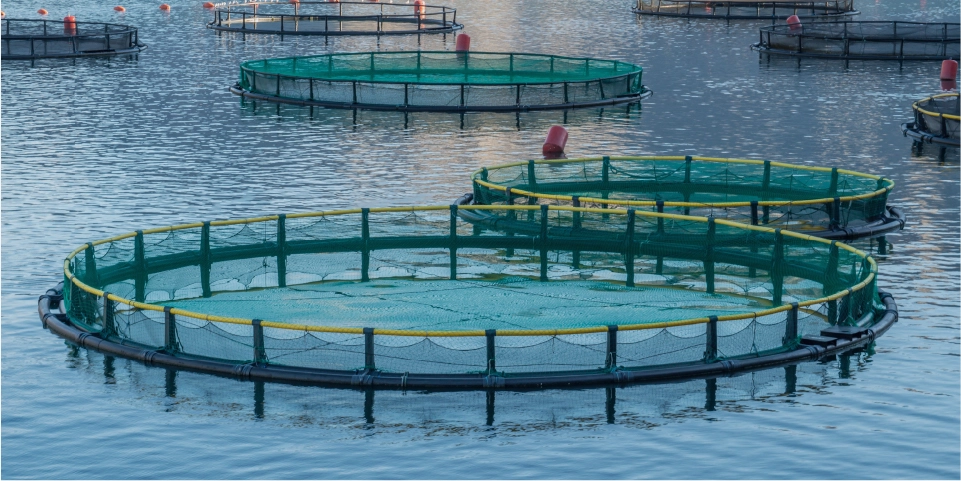Indonesia Proudly Claims Pempek as the Most Delicious Seafood Dish in the World
In the world of culinary delights, Pempek, a beloved Indonesian dish, has caught the attention of food enthusiasts worldwide. According to TasteAtlas, a global culinary encyclopedia, Pempek is rated an impressive 4.8, making it the world’s most delectable seafood dish. This rating is on par with Amêijoas à Bulhão Pato, a seafood dish from Portugal, and slightly higher than Japan’s iconic Sushi.
This savory dish is crafted from finely ground fish meat mixed with sago flour. Its allure lies in the perfect harmony of the chewy texture of the Pempek dough and the tenderness of the mackerel fish meat used. Each bite of Pempek offers a unique sensation.
Legend has it that Pempek was first introduced by a Chinese merchant known as “Apek.” He lived during the reign of Sultan Mahmud Badaruddin II in the Palembang Sultanate. Apek had the brilliant idea of utilizing the abundant fish by creating various dishes, one of which was Pempek. He ground fish meat, mixed it with sago flour, and fried it to a crisp and delicious perfection.
Pempek is readily available in numerous eateries, restaurants, and street food stalls across Indonesia. The primary ingredients for making Pempek are mackerel fish, sago flour, and water. The process involves extracting meat and skin from fresh mackerel. The fish meat is then minced and mixed with sago flour, water, and seasonings like garlic and salt. The mixture is then shaped into the desired type of Pempek.
There are various Pempek variations, including kapal selam (submarine), lenjer, adaan, and kulit (skin). Kapal selam Pempek has a chewy texture with a boiled egg filling in the center. Lenjer Pempek is cylindrical with a soft texture. Adaan Pempek is round, while kulit Pempek is flat and crispy due to the mackerel skin content.
Pempek is traditionally served with a distinctive spicy and tangy sauce called “kuah cuko.” The kuah cuko is made from a blend of ingredients like water, vinegar, sugar, salt, garlic, and chili. The combination of sweet, sour, and spicy flavors refreshes the palate when paired with Pempek. Additionally, Pempek can be garnished with fresh cucumber slices, dried shrimp (ebi), and crunchy crackers to enhance its deliciousness.
Presently, South Sumatra, particularly Palembang, has become the hub of Pempek production in Indonesia. According to the Pempek Entrepreneurs Association in Palembang, Pempek production reaches 11 tons per day and increases to 17 tons per day during the holy month of Ramadan. Besides catering to local consumers, Pempek is also sold to other regions and even internationally. The Greater Jakarta area is a primary destination for Pempek shipments from South Sumatra. Various countries, including the United States, Malaysia, Singapore, Australia, and Japan, import this Indonesian culinary gem.
As an internationally recognized dish, Pempek exemplifies Indonesia’s vast potential in the culinary industry. Its inclusion among the world’s most delicious seafood dishes in 2023 is not just an accomplishment but also a significant step in introducing Indonesia’s culinary richness to the international stage. Pempek serves as an Indonesian culinary ambassador, showcasing the expertise in transforming seafood into a delectable dish.
If you’re eager to try making Pempek at home, ensure that you use fresh, high-quality ingredients. You can rely on a trusted supplier of marine fish, such as Seafood by Aruna. By choosing high-quality mackerel fish, you can guarantee the optimal taste and texture of your Pempek. Your homemade Pempek will captivate your taste buds, in line with the internationally acclaimed Pempek delicacy.
Getting to Know the Pasteurization Process of Canned Blue Swimming Crab
In the world of seafood, canned crab meat is a popular choice for many people. This product has gained special attention due to its ease of serving. When you open a can of crab meat, you’ll find crab meat that’s ready to eat. This makes it a convenient option for delicious and healthy seafood dishes.
Canned crab meat is a source of high-quality protein often used in various food recipes. Many people prefer canned crab meat because of its convenience. You don’t need to go through the hassle of cleaning, cooking, or separating the meat from the shells. All the work has been done for you.
In addition to its user-friendliness, canned crab meat also has a reasonably long shelf life. This makes it a practical choice to keep in your kitchen. You can store several cans of crab meat as emergency food supplies or for everyday use.
Canned crab meat products also allow you to enjoy the delicious taste of crab meat whenever you want. You can use it as a base for dishes like salads, pastas, soups, or other seafood dishes. Experience the tenderness of crab meat in every bite.
Besides its convenience, canned crab meat also offers high nutritional benefits. Crab meat is rich in protein, which is essential for your body’s growth and maintenance. Additionally, crab meat contains various vitamins and minerals like vitamin B, selenium, and zinc, which are crucial for your health.
Canned crab meat also has a tender texture and a unique flavor. That’s why many people enjoy it in various dishes. You can combine it with other food ingredients to create delicious and nutritious meals.
In the seafood industry, the quality of canned crab meat is closely monitored. Pasteurization is used to ensure the safety and quality of the crab meat. The crab meat is heated to a specific temperature to kill any harmful microorganisms that may be present in the product. Afterward, the crab meat is immediately cooled to stop the pasteurization process. This allows the crab meat to stay fresh and safe during storage.
In the culinary world, canned crab meat is often a preferred choice for cooking delicious seafood dishes. You can create a variety of dishes, from crab sauces to fresh crab salads. Its tender texture and unique taste make it a perfect ingredient for your culinary creativity.
So, if you’re looking for a practical choice to enjoy high-quality crab meat, canned crab meat is the answer. This product offers many advantages, from ease of use to exceptional flavor quality. Crab is a promising seafood commodity, particularly regarding its potential for profitable exports. However, it’s essential to remember that crab meat is also susceptible to bacterial contamination that can damage the product if not handled and stored correctly. So, what’s the solution?
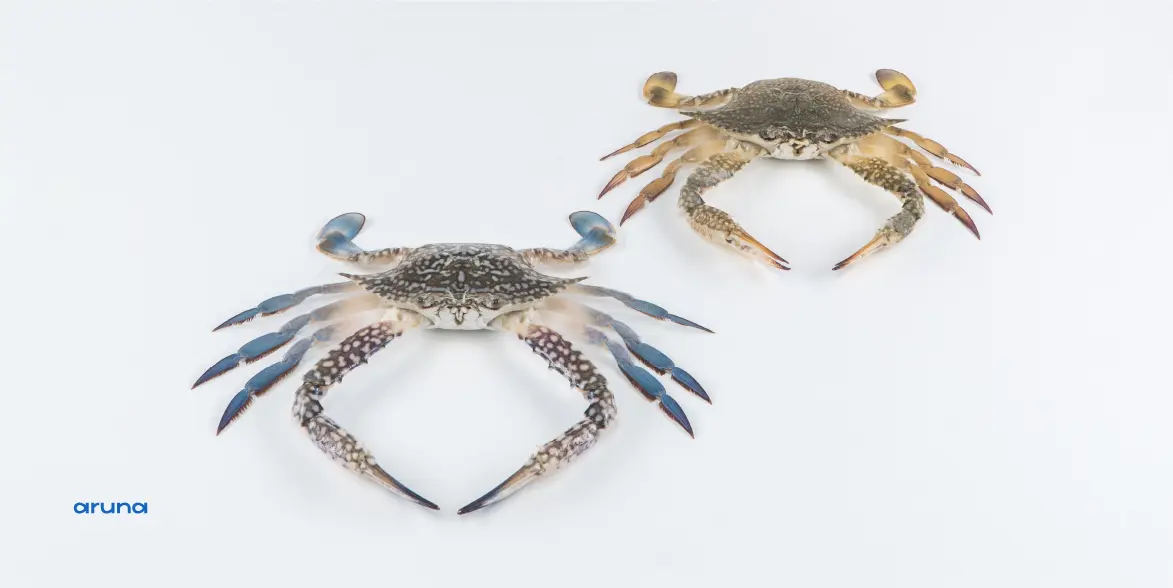
Pasteurization, one of the most effective ways
The journey from catching to handling it to consumers involves various stages, including capturing, processing, packaging, transporting, and storing. During this process, strict temperature control and good sanitation are required to prevent the growth of harmful microorganisms and maintain the quality of the meat.
One important way to maintain the quality of crab meat is by applying a pasteurization process. Pasteurization is a food processing technique that aims to reduce the number of pathogenic microorganisms in food products. This process involves heating the product to a certain temperature for a specified period of time, then proceeding with rapid cooling.
Getting to Know the Pasteurization Process in More Detail
In more detail, the pasteurization process involves cleaning the crab meat, separating it from the shells, and dividing it into its various parts. Following this, the crab meat is heated to a specific temperature, typically between 86-87 degrees Celsius, for around 140 minutes. Apris Modica, Quality Assurance at Aruna, emphasizes, “This stage is crucial because the pasteurization temperature and time must be precise to ensure that the crab meat is safe from pathogenic microorganisms. Right after that, the crab meat is cooled at a temperature of 0 to 2 degrees Celsius for 120 minutes before it’s packaged.”
The Benefits of Pasteurization
Pasteurization of crab meat provides several benefits. First, it can destroy pathogenic microorganisms, such as Salmonella and E. coli, which have the potential to cause diseases. Second, pasteurization extends the shelf life of crab meat by reducing the growth of destructive bacteria. This process allows crab meat to maintain its quality and freshness, both during transportation and storage.
With the pasteurization method, Aruna has successfully created high-quality crab meat that’s safe from dangerous microorganism contamination. BOON crab meat products not only maintain the delicious flavor and tender texture of crab meat but also ensure the safety and cleanliness of the product during storage and shipping. That’s why BOON crab meat from Aruna is the right choice for seafood enthusiasts looking for the best quality and ease of cooking. With BOON crab meat products, you can enjoy delicious and healthy crab meat at any time without worrying about its quality.
Advancing the Fisheries Main Industry through Collaboration
Farid Naufal Aslam, the Co-Founder and CEO of Aruna, shares his experiences while running Aruna, a company dedicated to making sustainable fisheries the driving force for the advancement of the fisheries main industry. This vision aligns with the government’s commitment to making the blue economy a central focus of national development, with maritime activities at its core.
Optimizing the Potential of the Biak Karon Indigenous Community
Many are still unaware of the crucial role that indigenous communities play in maintaining ecosystem balance and preserving marine resources. This is why the Nature Conservation Foundation of Indonesia (YKAN) supports the development of areas managed by indigenous legal systems. YKAN’s support for the development of indigenous legal communities is, in itself, an endorsement of the government’s ongoing efforts to empower these communities, which are integral to the implementation of sustainable fisheries practices.
The Government Continues to Promote Legal Empowerment of Indigenous Communities
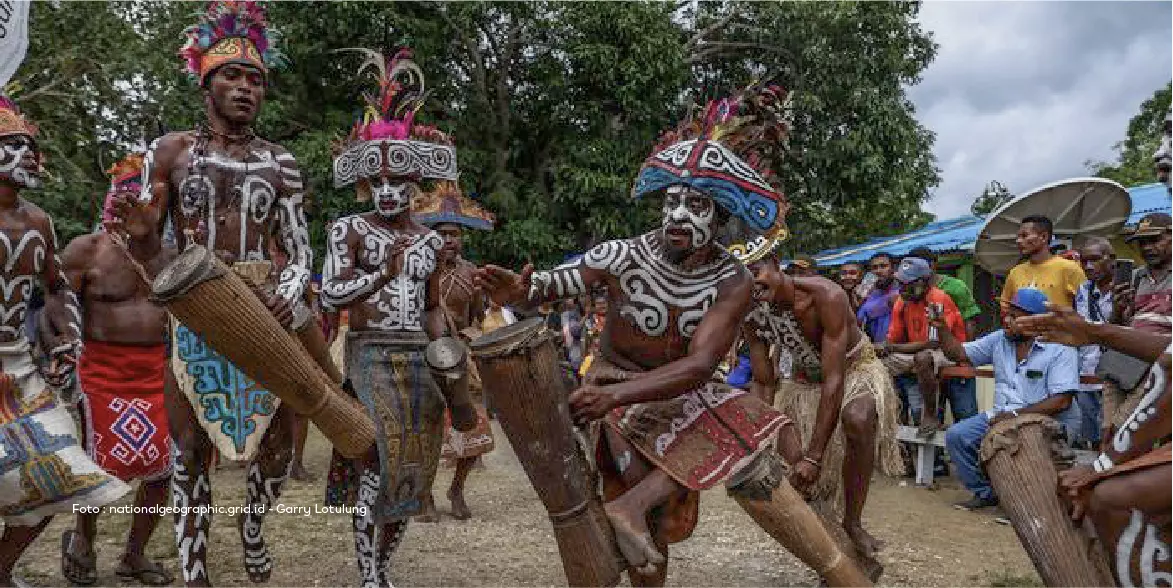
Since 2016, the government, through the Ministry of Marine Affairs and Fisheries (KKP), has facilitated the recognition and protection of 27 indigenous legal community communities, reinforced by 20 Regent/Mayor Regulations. YKAN believes that with a sound management framework, areas managed by indigenous communities can provide greater economic and ecological benefits. It is essential to provide support and guidance to blend traditional and modern knowledge, enabling indigenous communities to optimize their potential, whether in terms of marine tourism, maritime culture, aquaculture, or restoration.
One form of full government support to maximize the potential of indigenous communities is reflected in Tambrauw Regent Regulation No. 12 of 2019 concerning the Recognition and Protection of the Indigenous Legal Community of Werur in the Bikar District, which falls under the Indigenous Legal-Based Coastal and Marine Resource Management of Tambrauw Regency. This area is home to the Biak Karon indigenous community. YKAN collaborates with various partners to organize the Munara Beba Biyak Karon Indigenous Festival in Wenur Raya, Tambrauw Regency, South West Papua Province from March 22-25.
YKAN supports the government in making indigenous communities a vital pillar in preserving ecosystem sustainability by providing guidance to help them tap into their potential. The recent indigenous festival was not just filled with various cultural competitions, crafts, culinary delights, local products, and traditional arts to entertain, but it also aimed to strengthen the Biak Karon indigenous community, reviving their traditional wisdom.
The Biak Karon tribe’s festival included a variety of cultural contests, crafts, cuisine, unique products, and other traditional arts for entertainment, but it also marked the first time that all clans of the Biak Karon tribe gathered to support the success of the festival and conduct the sasi ceremony. According to local religious figures, the sasi tradition is a significant activity that the Biak Karon community had long abandoned and was no longer practiced by the local people. However, the sasi tradition plays a crucial role in coastal communities in maintaining ecosystem balance.
The Biak Karon Indigenous Community Sets a Positive Example in Fisheries Sustainability
Yunus Rumansara, Chairman of the Biak Karon Indigenous Council, joyfully exclaimed, “Utilizing natural resources wisely is the wisdom passed down from our ancestors. Through the festival and the revival of the sasi tradition, we strive to care for the environment, both now and for the future.” In an effort to demonstrate the commitment of the Biak Karon community to fisheries sustainability, this traditional festival concluded with a sasisen closing ceremony. This commitment serves as a positive example of sustainable fisheries for other coastal indigenous communities to follow.
The support provided by YKAN to optimize the potential of indigenous communities is praiseworthy and should be emulated by others. Aruna has also been actively involved in providing assistance and education to coastal communities, helping them improve the quality of their production and catch results in the fishing industry. With enhanced production quality, seafood suppliers and other stakeholders are willing to offer better prices to fishermen.
Oil Pollution Disrupts Aquaculture Efforts in Bintan
Fishermen engaged in aquaculture and fishing activities around Bintan Island are once again facing a bitter pill to swallow, as almost every part of the coastal area is bound to be contaminated by uncontrolled black oil. Several sources reveal that the presence of black oil polluting the coastline and coastal areas has been recurring for decades.
“Yes, we just have to accept it every year,” said Kurnia, the Chairman of Neighborhood Association (RT) 02 Neighborhood Unit (RW) 01 in Teluk Bakau Village, Gunung Kijang District, Bintan, Riau Islands. He expressed that they are powerless to address the issue of oil pollution in their area. Instead of reporting the incidents to the relevant authorities, he and the residents prefer to work together to clean up the oil waste because the presence of black waste has become a common occurrence. “Even if we clean it up, the waste will come back when the tide rises,” Kurnia explained.
In addition to disrupting aquaculture and fishing activities, it also has an impact on the tourism sector
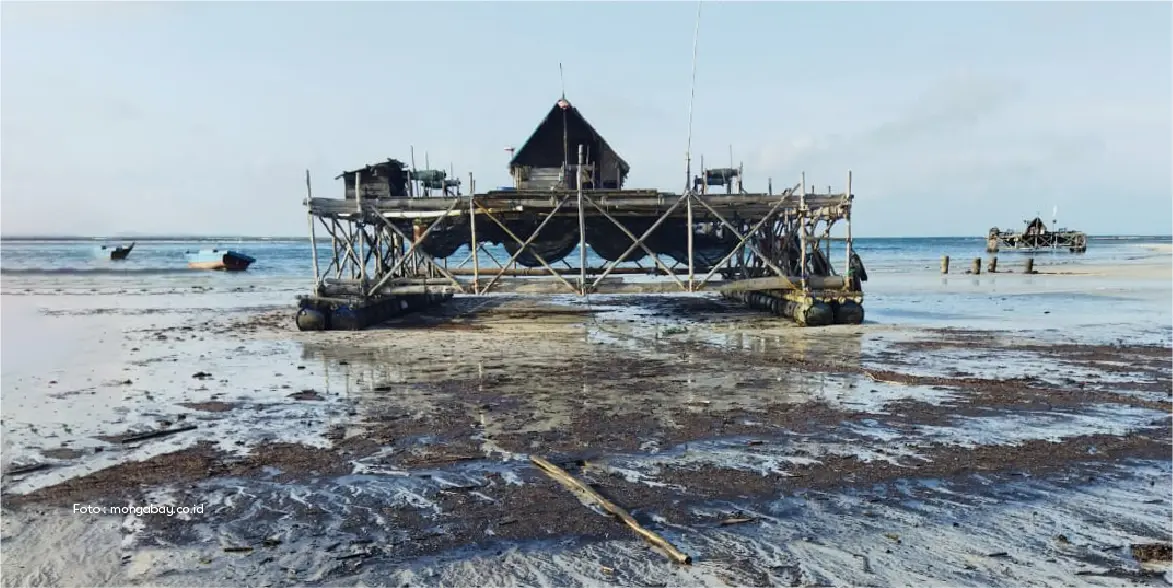
Apart from disrupting the activities of the local community, whose primary livelihoods are in aquaculture and fishing, the tourism sector also experiences significant losses every time this oil waste arrives. This includes popular destinations like White Sand, Gunawan Beach, Agro Beach, and Bamboo Beach, all located in Teluk Bakau Village. Bamboo Beach, in particular, has been known for offering clean beaches and delicious seafood for tourists. However, with the arrival of this waste, the management is forced to close their area. It’s worth noting that the seafood dishes served here are not purchased from external seafood suppliers but are the direct catch and cultivation of local fishermen.
The substantial presence of this oil waste undoubtedly disrupts the primary activities of coastal communities involved in aquaculture, as their fish farms also become contaminated. Additionally, the fishermen who go out to sea find their fishing gear automatically affected by the oil waste. This recurring waste not only disrupts the fishermen’s catches but also their livelihoods. Kurnia expressed hope that a solution can be found soon for the oil waste problem, so it no longer affects the livelihoods of the fishermen.
No Certainty About the Cause of the Oil Waste
The contaminated seawater not only pollutes the coastal areas but also generates air pollution, as the oil residue adhering to fish cages emits an unpleasant odor. To date, no one has successfully identified the source of the oil waste that disrupts the fisheries industry on Bintan Island. The operators of Bamboo Beach even revealed that this time the waste is far worse than in 2022.
The operators of tourist areas on Bintan Island have already brought this issue to the attention of PSDKP Bintan, the Department of Marine Affairs and Fisheries of the Riau Islands Province, the Harbor Master’s Office, and even the local military unit (Babinsa), with the hope that this problem, which has a massive impact on the people of Bintan, can be resolved promptly. The presence of oil waste presents a challenge to the government, which is currently focused on implementing various programs and policies to ensure the quality and sustainability of marine resources.
Aruna hopes that this longstanding and worsening issue can be addressed promptly. Efforts from the government and support from various stakeholders are crucial in identifying the source of the waste and preventing its recurrence. Meanwhile, Aruna Hub, together with the community and local heroes, continues to encourage fishermen to use environmentally friendly engines when at sea to prevent oil leaks from engines that can harm the environment and disrupt the natural balance.
Aruna’s Fisher Products Shine as Prime Fisheries Supply in America
In North America, the Seafood Expo North America (SENA) stands as the largest seafood exhibition. Thousands of stakeholders in the fisheries supply chain, including buyers and suppliers, gather for this three-day annual event. North America itself is a significant importer of various seafood products from around the world. At SENA, Aruna Crab, a premium crab product produced to meet global sustainability standards, took the spotlight, capturing the attention of attending buyers.
Aruna has been present in the North American market since 2017 and continues to thrive due to ongoing import demands. One of the key factors contributing to Aruna’s success in maintaining its position in the global fisheries supply chain is its commitment to delivering top-quality seafood products. International consumers now pay close attention to aspects like traceability, sustainable fisheries, and Good Manufacturing Practices (GMP) for every product entering their seafood supply chain.
Aruna Assists the Government in Global Fishery Product Marketing
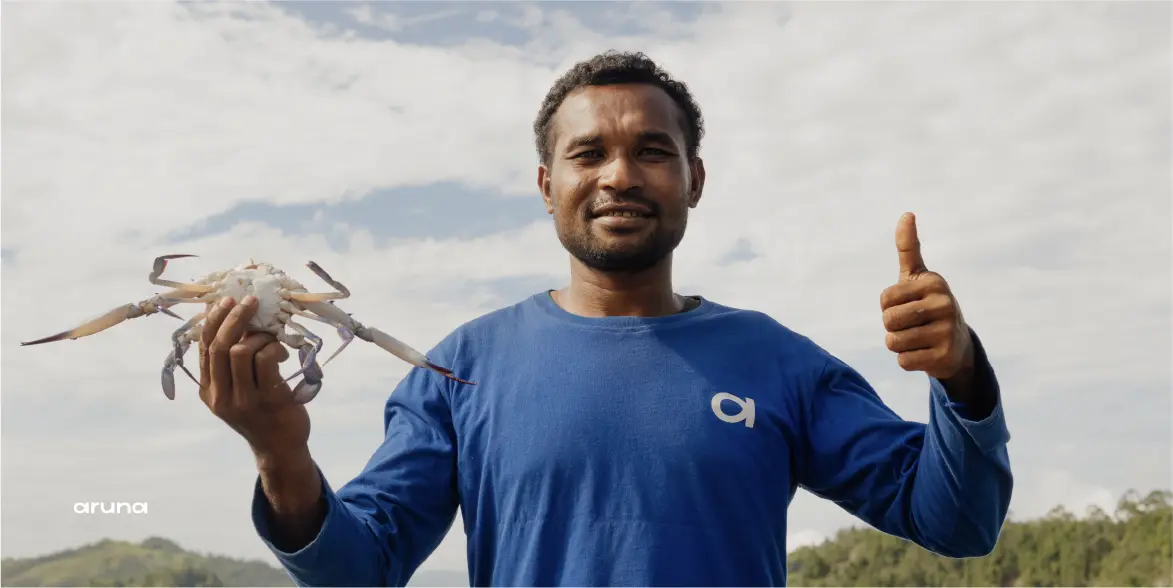
The Indonesian government, through the Ministry of Maritime Affairs and Fisheries, is actively promoting the export of fisheries products. They have targeted five fisheries product commodities to achieve global recognition: shrimp, lobster, crab, seaweed, and tilapia. As an integrated fisheries commerce and supply chain aggregator from Indonesia, Aruna has contributed to the Indonesian government’s goal by supplying three key commodities – crab, shrimp, and fish – for global fisheries supply, especially to America.
Aruna Focuses on Meeting International Fisheries Supply Demands with Globally Standardized Quality Products
Utari Octavianty, Co-Founder and Chief Sustainability Officer of Aruna, stated that Aruna’s products have been present in international markets, with a focus on different commodities for each country. For example, Aruna’s crab has gained recognition for its quality among American consumers, and Aruna consistently meets their demand for this product. Furthermore, other premium commodities from Aruna have also found favor with international consumers. To date, Aruna has produced over 23 premium fisheries products with international quality standards, catering to both domestic and international seafood retail consumers who can enjoy these high-quality Aruna products through the Seafood by Aruna e-commerce platform.
Up to this point, Aruna and the Aruna Hub ecosystem have grown alongside 40,000 Aruna fishermen and 500 coastal women, producing fisheries products that meet the highest Global Food Safety standards, making Aruna’s products suitable for international markets. Moreover, the government has taken steps to advance the fishery product downstream processing to boost the maritime economy. With the growth achieved so far, Aruna is increasingly optimistic about helping the Indonesian government internationalize its fishery products.
The Importance of Marine Resource Balance in Implementing Sustainable Fishing
Located in Panama, on Friday, March 3, 2023, an international event called the Global Ocean Accounts Partnership (GOAP) Side Event at the Our Ocean Conference (OOC) has just concluded. Victor Gustaaf Manopo, the Director-General of Marine Spatial Management representing the Government of Indonesia, specifically the Ministry of Maritime Affairs and Fisheries (MMAF), played an active role in this event by emphasizing the significance of ocean resource accounts in addressing the challenges of sustainable fishing management aligned with the blue economy direction.
Since 2021, a pilot project on marine resource accounts has been conducted in 7 Marine Conservation Areas (MCAs) and 1 fisheries region, establishing a strong foundation for Indonesia in determining the extent of ecosystems, conditions, and monetary values for mangroves, coral reefs, and seagrasses on a national scale. Victor revealed this development.
The Reasons Why Marine Resource Balance Matters in the Blue Economy and Sustainable Fishing
The definition of marine resource balance (MRB), according to the MMAF, is a structured and consistent compilation of information, including maps, data, statistics, and indicators about the marine and coastal environment, including social conditions and economic activities related to the seafood supply chain. MMAF has collaborated with GOAP on a pilot project to develop and compile MRB. The ministry, led by Sakti Wahyu Trenggono, views MRB as an ideal reference for implementing marine management that takes into account marine resource assets, economic flows, and the environment, which are closely linked to sustainable fishing.
MRB as an Instrument with National and Global Implications

Victor explained that the challenges of sustainable marine management lie in three aspects: protecting the ocean while maintaining its benefits for humanity, striving for increased ocean protection while considering economic aspects, and ensuring that goods and services from the ocean benefit all parties.
MMAF positions MRB as an instrument that should be involved to assist in the management of conservation areas, marine spatial planning, coastal ecosystem rehabilitation, and marine-based economic development. Considering its national and global policy implications, the Indonesian government prioritizes the development of MRB as something important and urgent. The national and global implications can be outlined as follows:
National Implications:
Providing data and information on biodiversity and ecosystems for national development that supports the achievement of Sustainable Development Goals (SDGs).
Global Implications:
Urgently contributing to Indonesia’s commitments in forums such as the Convention on Biological Diversity (CBD) and the High-Level Panel on Sustainable Ocean Economy (HLP-SOE).
Attended by Many Stakeholders, Indonesia Seizes Its Presence at OOC 2023
The Our Ocean Conference 2023 was attended by representatives from various countries, including Mike Kelloway, Chairman of the GOAP Council; Rick Spinrad, Deputy Administrator of NOAA (United States); Ilana Seid, Permanent Representative of Palau to the United Nations; Palau’s Ocean Panel Sherpa; Per W. Schive, Deputy Director-General of the Ministry of Climate and Environment (Norway); and Ilona Drewry, Head of International Sustainable Blue Finance (United Kingdom). Given that this international forum is a crucial platform for formulating various aspects for the success of the blue economy, it is highly appropriate to reiterate the significance of MRB, which was initiated by Minister Trenggono.
By actively participating in international forums related to SDGs and sustainable fisheries, the role of the Indonesian government will gain respect from other nations. Similarly, Aruna, representing the fishing companies in Indonesia, has consistently advocated for the betterment of national and global communities on various occasions. To advance the fisheries industry successfully, appropriate methods and instruments that preserve ecology must be employed. In the future, Aruna also envisions representing the national fisheries and marine ecosystem on the international stage.
5 Countries Successfully Implementing the Sustainable Fisheries Concept
The Government of the Republic of Indonesia has designated the maritime sector as a crucial axis of the future economy. Beyond embracing the blue economy, the government envisions Indonesia as a global maritime hub. In applying the blue economy, the concept of sustainable fisheries plays a pivotal role.
Countries that have succeeded in Implementing the Sustainable Fisheries Concept are Predominantly European Nations
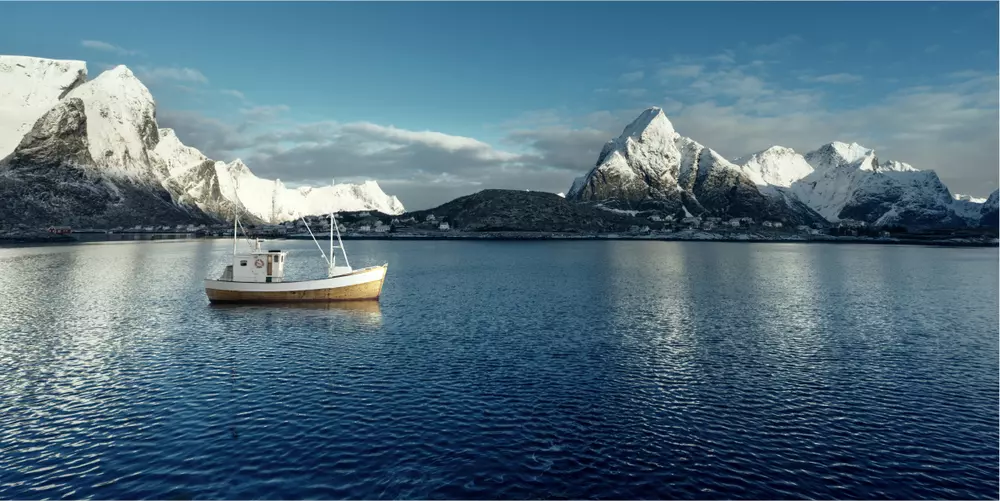 Implementing sustainable fisheries concepts is intricately linked to the blue economy, where economic progress must coexist with ecological preservation. Numerous countries acknowledge the significance of implementing sustainable fisheries concepts, and five countries have successfully put this sustainability concept into practice. Among these, four are European nations. Some of them include:
Implementing sustainable fisheries concepts is intricately linked to the blue economy, where economic progress must coexist with ecological preservation. Numerous countries acknowledge the significance of implementing sustainable fisheries concepts, and five countries have successfully put this sustainability concept into practice. Among these, four are European nations. Some of them include:
Canada
Canada has introduced various policies and practices for sustainable fisheries, proving effective. The nation employs stringent fisheries management systems, limiting the annual catch of fish. Moreover, Canada has developed a certification program for sustainable fisheries known as Fisheries Improvement Projects (FIPs).
United States
The United States has diligently worked toward implementing sustainable fisheries. It has introduced laws and regulations to cap fish catch and tightly control fishing activities. The U.S. has also established its certification program for sustainable fisheries, recognized as the Marine Stewardship Council (MSC). This program has successfully generated over 350 sustainable fish products in the global market.
New Zealand
New Zealand has implemented strict regulations to ensure the sustainability of its fisheries. Their effective fisheries management system includes setting fish catch limits, designating limited fishing zones, and prohibiting fishing in critical areas. New Zealand demonstrates a strong commitment to international fisheries sustainability by participating in various global forums and organizations.
Iceland
Iceland has been a leader in sustainable fisheries implementation. This Western European country has an effective fisheries management system, which includes catch limits and environmentally friendly technology usage to maintain marine resource sustainability. Iceland has also developed its own certification for sustainable fisheries called Responsible Fisheries Management.
Norway
Norway has led sustainable fisheries for decades, employing rigorous fisheries management systems. The Norwegian government restricts annual fish catch and maintains strict control over seafood supplier channels. Norway also possesses an internationally recognized certification system for sustainable fisheries. Presently, over 60% of fish caught in Norwegian waters are certified as sustainable fisheries.
The Indonesian government, through the Ministry of Maritime Affairs and Fisheries (KKP), has much to learn from countries that have advanced their fisheries industry through bilateral and multilateral cooperation in applying the sustainable fisheries concept. While advancing the maritime sector is not solely the government’s responsibility, all segments must unite in support and active involvement, spanning from producers to consumers.
As a supply chain aggregator, Aruna has been actively engaged in educating communities, from fishermen to broader consumers of seafood products, about the benefits of sustainable fisheries. Through the Aruna Hub ecosystem, coastal communities across various regions have received education on reducing fishing waste and transforming it into economically valuable products. This pursuit aligns with the mission to make the sea a better source of life for all.
The Vital Role of Extension Workers in Sustainable Fisheries Development
The Indonesian government has embraced the concept of the blue economy and aspires to position Indonesia as a global maritime hub. Both endeavors inherently demand a strong foundation in the maritime and fisheries sectors. As these sectors grow in importance, a comprehensive and capable strategy for sustainable fisheries development is essential to solidify Indonesia’s maritime domain as a resilient pillar of progress.
In the pursuit of sustainable fisheries development, the availability and competence of extension workers play a crucial role in realizing the success of priority programs outlined by the government, particularly the Ministry of Maritime Affairs and Fisheries. Extension workers serve as guides and conduits, conveying information about the fishing world from the central government to local regions. Given the pivotal role of fisheries extension personnel, it’s disheartening that field realities reveal an inadequate number of them to meet the demand.
Shortage of Fisheries Extension Personnel across Various Regions
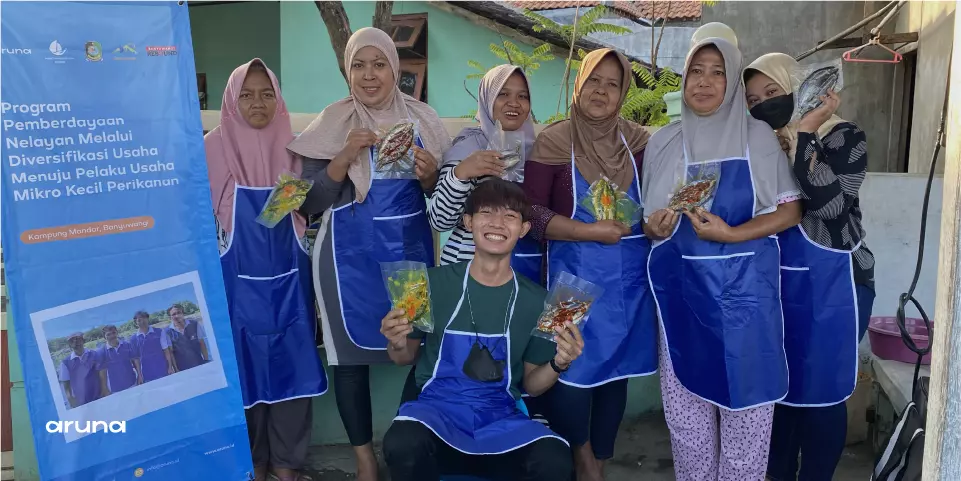
A notable case of this shortage is evident in Empat Lawang Regency, South Sumatra Province. Andi Ramlan S.Pi., the Coordinator of Fisheries Extension for Empat Lawang Regency, disclosed that his working area has only seven individuals comprising the fisheries extension team within the Regency’s Fisheries Department. However, there are ten sub-districts in Empat Lawang, and in the Pendopo Sub-District, ideally, two to three extension workers should be provided due to the more substantial fishing activities compared to other sub-districts.
“Ideally, there should be one fisheries extension worker per sub-district. We have ten sub-districts. However, it also depends on the fishing area. For instance, in the Pendopo Sub-District, ideally, there should be two or three fisheries extension workers,” Andi Ramlan stated. Considering their critical responsibilities in coordinating fisheries activities at the Fishery Extension Administrative Unit (satminkal) and the Provincial Maritime and Fisheries Office, South Sumatra, it becomes even more pressing. Additionally, fisheries extension workers are tasked with verification, signing off on fishery extension reports and attendance, and executing other duties delegated by the Marine and Fisheries Human Resources Research and Development Agency (BRSDM KP).
Impact of Fisheries Extension Personnel Shortage on Sustainable Fisheries Development
The issue of human resource shortage within the Ministry of Maritime Affairs and Fisheries must be addressed promptly, especially considering the government’s recent reforms in the maritime and fisheries education system, merging all units into the Ocean Institute of Indonesia (OII). If the number of fisheries extension personnel falls short of the ideal amount, the implementation of sustainable fisheries development could be delayed due to ineffective dissemination of information from the central level to local regions, inevitably hindering the progress of the fisheries industry.
Local Heroes and Aruna Hub: Aruna’s Recognition of the Importance of Fisheries Extension Personnel
Aruna, a fisheries-focused company dedicated to improving the lives of fishermen through sustainable fishing practices, is well aware of the significance of mentors and extension workers in overseeing fishing activities. Through the active role of the marine and fisheries ecosystem of Aruna Hub and the Local Heroes in each region, Aruna has successfully transferred knowledge, information, and technology to coastal communities. Not only fishermen but also non-fishing communities along the coast have experienced positive impacts.
Aruna has educated coastal residents, particularly women, on producing derivative products from leftover catches or aquaculture activities. These products are then aided in marketing to reach potential consumers such as restaurants, hotels, and seafood suppliers across various regions and even internationally. Hence, the reality of numerous coastal areas in Indonesia lacking fisheries extension personnel is concerning. It is hoped that the government collaborates with academia and the private sector to swiftly address this human resource shortage issue.
PLN Supports the Progress of Sustainable Fisheries and Aquaculture
PLN Supports the Progress of Sustainable Fisheries and Aquaculture
The implementation of sustainable fisheries and aquaculture in a country would not succeed without the cross-sectoral support provided. This is because the principles of sustainability must be comprehensively applied, and their implementation inevitably intersects with sectors beyond marine and fisheries, overseen by the Ministry of Maritime Affairs and Fisheries (KKP). One form of cross-stakeholder support is the assistance given by the State Electricity Company (PT. PLN (Persero)) to cultivation actors in Central Sulawesi Province.
The Central Sulawesi Provincial Government (Pemprov Sulteng) receives support from one of the State-Owned Enterprises responsible for electricity distribution, namely PT. PLN (Persero), through the Electrifying Agriculture (EA) program. This EA program is carried out in line with the central government’s decree, targeting shrimp production in Central Sulawesi to reach 5,000 tons per year. Governor of Central Sulawesi, Rusdy Mastura, also revealed that the provincial government is currently fostering various collaborations to promote the expansion of the existing fisheries land utilization in Central Sulawesi.
Central Sulawesi Province is recorded to possess potential fisheries land covering an area of 42,095 hectares, yet the realized utilization rate is only 25%. Of course, the provincial government will continue to accelerate the realization of fisheries land utilization by establishing policies for the marine and fisheries sector in Central Sulawesi that remain aligned with the implementation of the blue economy, emphasizing sustainable fisheries and aquaculture or the optimal utilization of marine resources while maintaining conservation efforts for ecological balance.
Rusdy’s strategy to optimize and strengthen the industrialization of aquaculture and boost capture fisheries production in line with the blue economy direction involves prioritizing collaboration. “In 2023 and beyond, Central Sulawesi will continue to collaborate in enhancing the well-being of fishermen, including cultivators, processors, and marketers of fisheries products, contributing to employment absorption,” he concluded.
EA Assists Businesses in Harnessing Technology in Maritime and Fisheries Activities
![Sustainable Fisheries and Aquaculture]()
The sustainable development of fisheries and fish cultivation in Central Sulawesi receives a boost from the State Electricity Company’s (PLN) Energy Application (EA) program. Through the provision of modern electricity and technological solutions for the agricultural sector, the EA program helps enhance productivity and reduce operational costs for farmers, livestock breeders, and fishermen.
For the rapidly growing shrimp cultivation industry in Central Sulawesi, the PLN’s EA program opens new opportunities to leverage electricity-based technology for improving harvest yields while cutting costs. Data shows that in 2022 alone, 134 PLN customers in this province benefited from the EA program. Furthermore, PLN plans to add a capacity of 50 megawatts to Unit 1 of the Palu 3 Thermal Power Plant in 2023.
PLN’s genuine support as a State-Owned Enterprise in the development of the fisheries industry deserves appreciation, as it demonstrates that the government not only acts as a regulator but also provides direct assistance through its business entities. We at Aruna certainly support every effort by the Central Sulawesi Provincial Government to prioritize modernization and technology utilization for advancing the economy, particularly in sustainable fisheries and fish cultivation.

